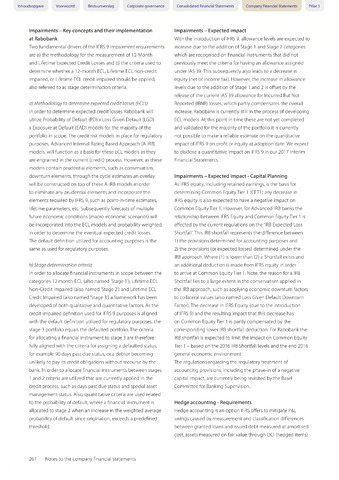Inhoudsopgave Voorwoord Bestuursverslag Corporate governance
Consolidated Financial Statements Company Financial Statements Pillar 3
Impairments - Key concepts and their implementation
at Rabobank
Two fundamental drivers of the IFRS 9 impairment requirements
are a) the methodology for the measurement of 12-Month
and Lifetime Expected Credit Losses and b) the criteria used to
determine whether a 12-month ECL, Lifetime ECL non-credit
impaired, or Lifetime ECL credit impaired should be applied,
also referred to as stage determination criteria.
a) Methodology to determine expected credit losses (ECL's)
In order to determine expected credit losses Rabobank will
utilize Probability of Default (PD) x Loss Given Default (LGD)
x Exposure at Default (EAD) models for the majority of the
portfolio in scope. The credit risk models in place for regulatory
purposes, Advanced Internal Rating Based Approach (A-IRB)
models, will function as a basis for these ECL models as they
are engrained in the current (credit) process. Flowever, as these
models contain prudential elements, such as conservatism,
downturn elements, through the cycle estimates an overlay
will be constructed on top of these A-IRB models in order
to eliminate any prudential elements and incorporate the
elements required by IFRS 9, such as point-in-time estimates,
lifetime parameters, etc. Subsequently forecasts of multiple
future economic conditions (macro-economic scenarios) will
be incorporated into the ECL models and probability weighted
in order to determine the eventual expected credit losses.
The default definition utilized for accounting purposes is the
same as used for regulatory purposes.
b) Stage determination criteria
In order to allocate financial instruments in scope between the
categories 12 month-ECL (also named 'Stage T), Lifetime ECL
Non-Credit Impaired (also named 'Stage 2') and Lifetime ECL
Credit Impaired (also named 'Stage 3') a framework has been
developed of both qualitative and quantitative factors. As the
credit-impaired definition used for IFRS 9 purposes is aligned
with the default definition utilized for regulatory purposes, the
stage 3 portfolio equals the defaulted portfolio.The criteria
for allocating a financial instrument to stage 3 are therefore
fully aligned with the criteria for assigning a defaulted status,
for example 90 days past due status, or a debtor becoming
unlikely to pay its credit obligations without recourse by the
bank. In order to allocate financial instruments between stages
1 and 2 criteria are utilized that are currently applied in the
credit process, such as days past due status and special asset
management status. Also, quantitative criteria are used related
to the probability of default, where a financial instrument is
allocated to stage 2 when an increase in the weighted average
probability of default since origination, exceeds a predefined
threshold.
Impairments - Expected impact
With the introduction of IFRS 9, allowance levels are expected to
increase due to the addition of Stage 1 and Stage 2 categories
which are recognised on financial instruments that did not
previously meet the criteria for having an allowance assigned
under IAS 39. This subsequently also leads to a decrease in
equity (net of income tax). Flowever, the increase in allowance
levels due to the addition of Stage 1 and 2 is offset by the
release of the current IAS 39 allowance for Incurred But Not
Reported (IBNR) losses, which partly compensates the overall
increase. Rabobank is currently still in the process of developing
ECL models. At this point in time these are not yet completed
and validated for the majority of the portfolio it is currently
not possible to make a reliable estimate on the quantitative
impact of IFRS 9 on profit or equity at adoption date. We expect
to disclose a quantitative impact on IFRS 9 in our 2017 Interim
Financial Statements.
Impairments - Expected impact - Capital Planning
As IFRS equity, including retained earnings, is the basis for
determining Common Equity Tier 1 (CET1) any decrease in
IFRS equity is also expected to have a negative impact on
Common Equity Tier 1Flowever, for Advanced-IRB banks the
relationship between IFRS Equity and Common Equity Tier 1 is
effected by the current regulations on the 'IRB Expected Loss
Shortfall'.This IRB shortfall represents the difference between
1) the provisions determined for accounting purposes and
2) the provisions (or expected losses) determined under the
IRB approach. Where (1) is lower than (2) a Shortfall exists and
an additional deduction is made from IFRS equity in order
to arrive at Common Equity Tier 1Note, the reason for a IRB
Shortfall lies to a large extent in the conservatism applied in
the IRB approach, such as applying economic downturn factors
to collateral values (also named Loss Given Default Downturn
Factor). The decrease in IFRS Equity (due to the introduction
of IFRS 9) and the resulting impact that this decrease has
on Common Equity Tier 1 is partly compensated by the
corresponding lower IRB shortfall deduction. For Rabobank the
IRB shortfall is expected to limit the impact on Common Equity
Tier 1 - based on the 2016 IRB Shortfall levels and the end 2016
general economic environment.
The regulations regarding the regulatory treatment of
accounting provisions, including the phase-in of a negative
capital impact, are currently being revisited by the Basel
Committee for Banking Supervision.
Hedge accounting - Requirements
Hedge accounting is an option IFRS offers to mitigate P&L
swings caused by measurement and classification differences
between granted loans and issued debt measured at amortised
cost, assets measured on fair value through OCI (hedged items)
261 Notes to the company financial statements

